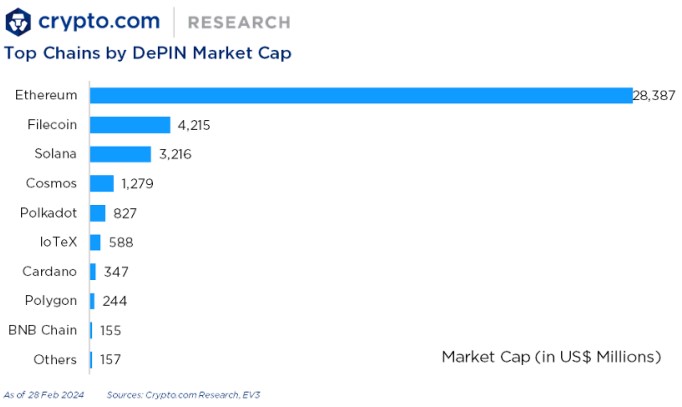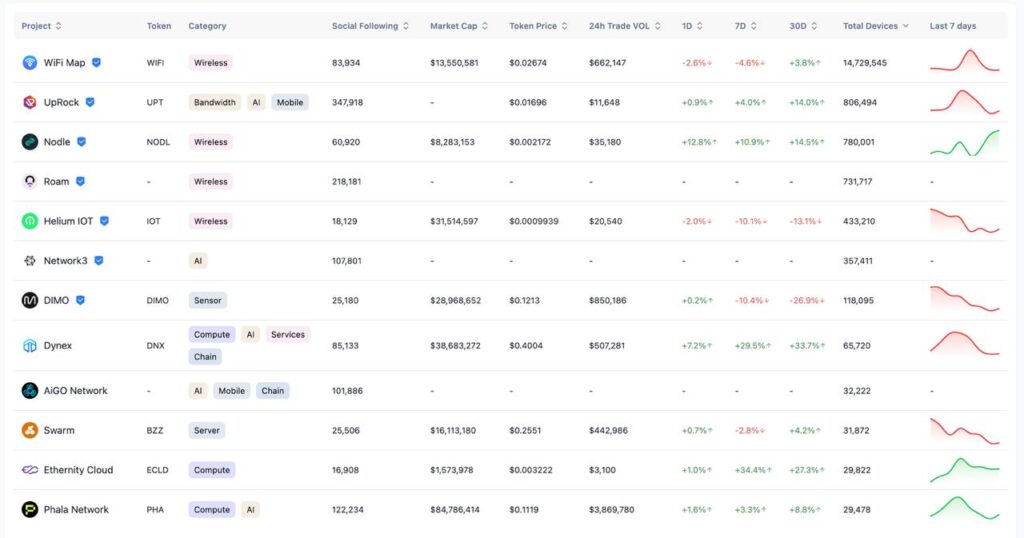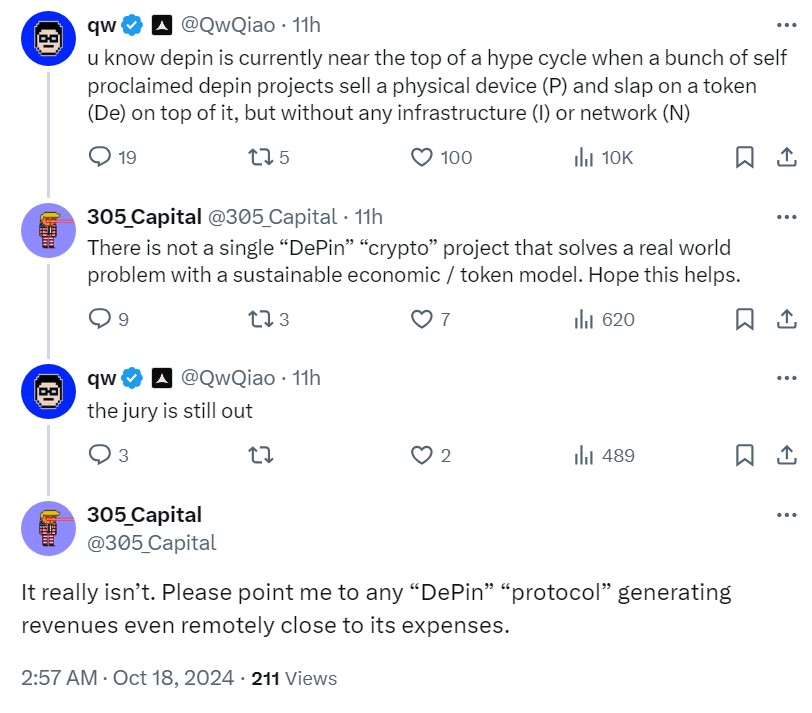DePIN — short for Decentralized Physical Infrastructure Network — is one of the hottest new narratives in crypto. However, the extent to which current DePIN projects actually rely on blockchain networks is an open question.
Dubbed the “Internet of Things (IoT) with a blockchain twist,” DePIN projects connect and manage physical devices that collect and exchange data, like wireless networks, energy grids or storage systems.
These networks produce huge amounts of data, so connecting DePIN via blockchain requires high-throughput chains — and even then, blockchains can only record a small component of the data.
Helium, one of the best-known DePIN projects that connect wireless networks, ditched its own chain to move to Solana in April 2023, which is one of the fastest options currently available. However, even Solana’s efficiency falls short for DePIN projects that demand real-time computation capabilities.
Are DePIN projects really onchain?
“Existing DePIN use cases are, in fact, not fully onchain,” Shuyao Kong, co-founder of the soon-to-launch MegaETH, tells Magazine. The Ethereum L2 aims to process 100,000 transactions per second which may be enough for some DePIN projects.
So are DePIN projects just labeling themselves with “blockchain” as a marketing ploy to attract venture capitalists?
Some might be. But the bigger issue is that at present, fully onchain DePIN applications are inefficient and costly. So projects employ a hybrid structure, conducting offchain computation and recording results onchain.
Kong said on a recent podcast that a Solana co-founder had approached her about a fitness tracker that needed real-time biometric data computations, which Solana can’t do. Kong claims forthcoming Ethereum L2 MegaETH will have that capacity.
Why DePIN projects rely on offchain computation
Zhe Wang, CEO of DEPHY network — a project that bridges offchain DePIN data to blockchains — classifies IoT into two main categories: sensors and executors.
Sensors collect data from physical environments and don’t necessarily require instant message delivery, think networks of weather sensors or step counters.
Latency for sensors is more tolerable than for executors explains Wang, which are devices that act on command.
Delays in executor computations, like those needed for driving or controlling lights, can cause discomfort or even pose danger.
“It will be so bad if you ask to turn off the lights in your bedroom [and] it’s delivered in 10 minutes,” Wang tells Magazine, “but if your step count is calculated in a day, it’s fine.”

Although sensor data could be more easily transferred onchain, it’s still not ideal, as continuous or large-scale data transmission can become costly and inefficient.
Why use blockchain for DePIN?
So if both sensor and executor data are better-computed offchain, then what purpose does blockchain even serve for DePIN?
“DePIN projects use blockchains because they are a way of coordinating the activity of thousands if not millions of devices, in a permissionless way that doesn’t require each of the devices to trust each other,” Wes Levitt, head of strategy at Theta Labs, tells Magazine.
While computation is often needed for DePIN use cases, it’s typically handled separately from what is recorded onchain.
As the name suggests, DePIN aims to decentralize physical infrastructure, which requires participants to host devices, provide bandwidth, or share data. But despite its advantages, blockchain is not actually required to run decentralized infrastructure. Tor, a decentralized alternative internet with thousands of nodes worldwide, is one of the most well-known examples.
Tor operates thanks to volunteers motivated by common interests, like privacy advocacy and technical experimentation.
Blockchain adds a financial incentive layer to participation by rewarding contributors with tokens.
For example, DePIN marketplaces such as CUDOS and Akash enable users to contribute computing power, including GPUs, which can be rented for AI services or other high-demand tasks. This allows contributors to earn tokens in return for sharing their resources, creating a more economically sustainable system
“That’s what is done in our Theta EdgeCloud platform and by many other DePIN projects,” Levitt says. EdgeCloud nodes typically handle AI processing or video rendering tasks, which can take nodes anywhere from a few minutes to several hours to complete.

Levitt argues that there’s no value in sending partially completed jobs onchain every few seconds. Instead, nodes only need to submit proof of completion for verification and payment.
“In most cases, it’s sufficient for nodes to send proof-of-work or coverage regularly over a given period of time, perhaps with some collateral to ensure compliance between verifications,” he says.
Best and worst blockchain networks for DePIN projects
Ethereum is the largest blockchain that could handle DePIN, but the L1 is totally unsuited due to its slow TPS. Layer 2 solutions, like Base and Arbitrum, can handle more transactions, but these still number in the hundreds per second at best.

But 2025 could be the year that blockchains take their biggest strides toward scaling yet.
MegaETH — short for “Make Ethereum Great Again” — is a Vitalik Buterin-backed L2 chain that uses an optimized sequencer to provide scalability while maintaining Ethereum’s security. While it promises 100,000 TPS, it is yet to launch.
Sui, which is based on Facebook’s Move language, has recently entered the competition, claiming a theoretical maximum of near 300,000 transactions per second — surpassing even MegaETH’s near real-time efficiency.
However, in October, Sui’s highest recorded averageTPS was 822, with a low of 106 TPS on Oct. 16. (That said, TPS relies on demand as well as capability, and real-world TPS is invariably much lower than on testnet.)
Solana remains one of the fastest layer-1 blockchains, with a theoretical maximum of 65,000 TPS, but it typically averages around 3,000 TPS, according to Solscan. The upcoming Firedancer client, currently on testnet, is aiming for 1 million TPS.
But Wang argues that even such impressive throughput won’t be enough to handle a DePIN project to fully operate on the blockchain.

He says that even a blockchain running at 1 million TPS still wouldn’t be enough to handle the vast amount of computing power DePIN requires.
WiFi Map has over 14 million devices, according to DePIN Scan. This means even if a device sends a single message every 10 seconds (which is a very generous example for IoT real-time computation examples), that blockchain would need 1.4 million transactions per second for that single project.
At 1.4 million transactions per second and a gas fee of $0.024 per transaction (Solana’s typical fees), the project would be $33,600 per second.
“I don’t foresee fully onchain DePIN projects becoming the norm in the near future. The real-time computational demands and massive data throughput required by many DePIN applications simply outpace what current blockchain architectures can handle entirely onchain,” Jeremy Frank, head of engineering at Autonomys Network, a distributed storage project powered by blockchain and AI, tells Magazine.
“That said, I do expect we’ll see an increasing portion of DePIN functionality move onchain over time as scalability improves.”
Future of DePIN: Evolving blockchains and specialized architectures
Currently, no blockchain can support true real-time transactions for DePIN projects, Wang claims.
But real-time computation may not be essential for all DePIN applications, and its not the case these projects lace themselves with “blockchain” as a marketing ploy to attract venture capitalists.
DePIN projects often split their architecture between onchain and offchain components to improve scalability and performance, while onchain components provide incentives and trustless verifiability.
Ultimately, while DePIN pushes the boundaries of blockchain technology, its success will likely depend on finding a balance between onchain and offchain processes.
Frank believes future DePIN projects will evolve toward more modular and specialized architectures that can handle the various computational needs of different applications.
“We’ll likely see purpose-built execution environments optimized for specific DePIN verticals, whether that’s real-time biometric processing, large-scale data storage, or high-frequency sensor networks.”
week.

The post Most DePIN projects barely even use blockchain: True or false? appeared first on Cointelegraph Magazine.
